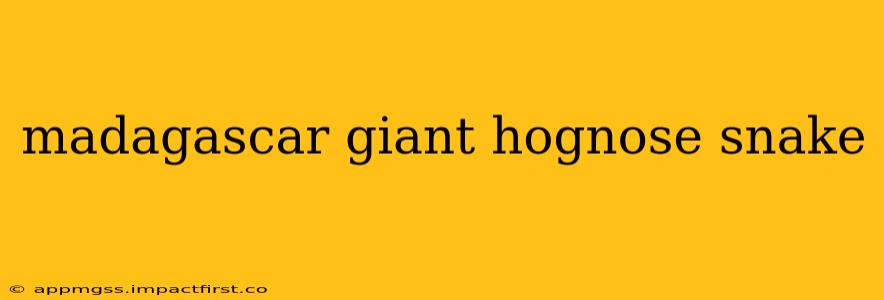The Madagascar giant hognose snake ( Langaha madagascariensis) is a truly unique and fascinating reptile. Its striking appearance, intriguing behavior, and conservation status make it a subject of significant interest for herpetologists and reptile enthusiasts alike. This comprehensive guide will delve into various aspects of this remarkable species, answering common questions and providing insights into its natural history and current conservation challenges.
What Makes the Madagascar Giant Hognose Snake Unique?
The Madagascar giant hognose is easily distinguished by its distinctive upturned snout, giving it a somewhat pig-like appearance – hence the "hognose" in its name. This unique snout is an adaptation for its fossorial (burrowing) lifestyle, allowing it to effectively probe the soil in search of prey. Unlike many other snakes, it's primarily a burrower, spending a significant portion of its life underground. Its coloration also contributes to its unique identity; it sports a range of browns, grays, and yellows, providing excellent camouflage in its native habitat. Its size is also impressive, reaching lengths of over 1 meter (3.3 feet) in some cases.
What Does a Madagascar Giant Hognose Snake Eat?
The Madagascar giant hognose snake's diet primarily consists of amphibians and other small vertebrates. They are skilled hunters, utilizing their specialized snout to locate prey beneath the surface. Their diet can include various frogs, toads, lizards, and occasionally rodents. Their hunting strategy typically involves ambushing prey from a concealed position.
Where Does the Madagascar Giant Hognose Snake Live?
As its name suggests, the Madagascar giant hognose snake is endemic to the island of Madagascar. Its habitat is characterized by dry forests and scrublands, where it can effectively burrow and find ample prey. The specific regions inhabited by these snakes vary across the island.
Is the Madagascar Giant Hognose Snake Poisonous?
No, the Madagascar giant hognose snake is not venomous. While it possesses a powerful bite as a defensive mechanism, it poses no significant threat to humans beyond a painful nip. It is much more likely to rely on defensive displays such as hissing, flattening its body, and even striking to deter potential predators.
How Big Do Madagascar Giant Hognose Snakes Get?
As mentioned earlier, Madagascar giant hognose snakes can attain impressive lengths. While average sizes may vary, mature individuals can easily exceed 1 meter (3.3 feet) in length, with some exceeding this size.
What are the Conservation Status and Threats to the Madagascar Giant Hognose Snake?
The Madagascar giant hognose snake is currently classified as Vulnerable by the IUCN. This classification reflects the significant threats the species faces, primarily driven by habitat loss due to deforestation. Agricultural expansion, logging, and the increasing human encroachment on their natural habitat are major contributing factors to their dwindling populations. The illegal pet trade also poses a considerable threat.
What is the Madagascar Giant Hognose Snake's Behavior Like?
The Madagascar giant hognose is primarily a nocturnal and secretive creature. Their behavior is characterized by their fossorial lifestyle and their reliance on ambush hunting. They are not overtly aggressive towards humans, but will defend themselves if threatened.
Can I Keep a Madagascar Giant Hognose Snake as a Pet?
While these snakes can make fascinating pets for experienced reptile keepers, keeping a Madagascar giant hognose snake requires extensive knowledge and resources. These snakes have specific habitat and dietary requirements. It is crucial to ensure the snake's origin is legal and ethical, supporting captive breeding programs that do not contribute to the depletion of wild populations. Improper care can lead to health issues and reduced lifespan for the animal. Responsible pet ownership is paramount.
This guide provides a comprehensive overview of the Madagascar giant hognose snake. Further research into specific aspects, such as captive breeding techniques or detailed regional distribution maps, can offer deeper understanding for those passionate about this fascinating species. Remember, the continued survival of the Madagascar giant hognose snake depends on our collective efforts in conservation and responsible practices.
